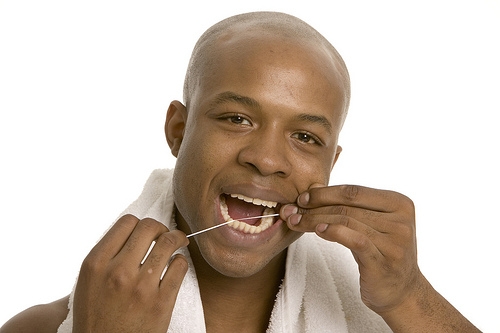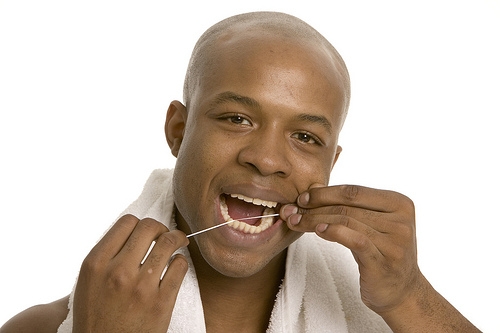July 6th, 2022

At Downey Orthodontics, we prefer our patients to practice good oral hygiene between office visits. Part of that process includes flossing, which Dr. Nathan Downey will tell you, is the process of cleaning between the teeth to remove food and debris from the areas that are hard to reach with a toothbrush. When food is allowed to remain between the teeth, it provides a breeding ground for bacteria, which can cause periodontal disease.
Should you floss before or after brushing?
You can floss either before or after brushing, according to your own preference. By flossing first, you can brush away dislodged food debris afterward. On the other hand, brushing first allows you to loosen plaque between the teeth, making it easier to floss more effectively.
Whichever you choose, the most important goal is to floss thoroughly. That means using a fresh strand of dental floss each day, and carefully pulling it back and forth between all of the teeth. Do not skip flossing because your teeth look or feel clean.
When to Floss
Unlike brushing, you need only floss between your teeth once per day. Although you may choose to do it in the morning or afternoon, many prefer to floss at night to prevent food and debris from remaining in the crevices of the teeth overnight. This could prevent the build-up of plaque too, which is a cause of tooth decay.
Help with Flossing
If you have questions about your flossing technique or what type of floss is best for your teeth, contact our office. Our staff will be more than happy to assist you in perfecting your home hygiene regimen. In most cases, you can choose between interdental cleaning picks or flexible floss strands to perform your daily flossing routine. If you have permanent oral appliances or restorations, be sure to follow the flossing instructions provided to you, and contact our Bowling Green, OH office with any questions.
July 6th, 2022

At Downey Orthodontics, we prefer our patients to practice good oral hygiene between office visits. Part of that process includes flossing, which Dr. Nathan Downey will tell you, is the process of cleaning between the teeth to remove food and debris from the areas that are hard to reach with a toothbrush. When food is allowed to remain between the teeth, it provides a breeding ground for bacteria, which can cause periodontal disease.
Should you floss before or after brushing?
You can floss either before or after brushing, according to your own preference. By flossing first, you can brush away dislodged food debris afterward. On the other hand, brushing first allows you to loosen plaque between the teeth, making it easier to floss more effectively.
Whichever you choose, the most important goal is to floss thoroughly. That means using a fresh strand of dental floss each day, and carefully pulling it back and forth between all of the teeth. Do not skip flossing because your teeth look or feel clean.
When to Floss
Unlike brushing, you need only floss between your teeth once per day. Although you may choose to do it in the morning or afternoon, many prefer to floss at night to prevent food and debris from remaining in the crevices of the teeth overnight. This could prevent the build-up of plaque too, which is a cause of tooth decay.
Help with Flossing
If you have questions about your flossing technique or what type of floss is best for your teeth, contact our office. Our staff will be more than happy to assist you in perfecting your home hygiene regimen. In most cases, you can choose between interdental cleaning picks or flexible floss strands to perform your daily flossing routine. If you have permanent oral appliances or restorations, be sure to follow the flossing instructions provided to you, and contact our Bowling Green, OH office with any questions.
July 6th, 2022

At Downey Orthodontics, we prefer our patients to practice good oral hygiene between office visits. Part of that process includes flossing, which Dr. Nathan Downey will tell you, is the process of cleaning between the teeth to remove food and debris from the areas that are hard to reach with a toothbrush. When food is allowed to remain between the teeth, it provides a breeding ground for bacteria, which can cause periodontal disease.
Should you floss before or after brushing?
You can floss either before or after brushing, according to your own preference. By flossing first, you can brush away dislodged food debris afterward. On the other hand, brushing first allows you to loosen plaque between the teeth, making it easier to floss more effectively.
Whichever you choose, the most important goal is to floss thoroughly. That means using a fresh strand of dental floss each day, and carefully pulling it back and forth between all of the teeth. Do not skip flossing because your teeth look or feel clean.
When to Floss
Unlike brushing, you need only floss between your teeth once per day. Although you may choose to do it in the morning or afternoon, many prefer to floss at night to prevent food and debris from remaining in the crevices of the teeth overnight. This could prevent the build-up of plaque too, which is a cause of tooth decay.
Help with Flossing
If you have questions about your flossing technique or what type of floss is best for your teeth, contact our office. Our staff will be more than happy to assist you in perfecting your home hygiene regimen. In most cases, you can choose between interdental cleaning picks or flexible floss strands to perform your daily flossing routine. If you have permanent oral appliances or restorations, be sure to follow the flossing instructions provided to you, and contact our Bowling Green, OH office with any questions.
June 29th, 2022

Did you know that the most common oral health diseases are tooth decay and gum disease? Not so coincidentally, they are also the easiest to prevent. As much as we would like for the brushing and flossing to do all the work for us, in reality, we really are what we eat — and a healthy diet is just as important for dental health as it is for the rest of the body.
Eating well boosts your immune system, and makes you less susceptible to gum disease and tooth decay. When you maintain a balanced diet, you provide your body with all the nutrients it needs to succeed. So what does a healthy, balanced diet entail? It’s really quite simple. Here are some tips:
- Focus on lean meats, veggies, whole grains, and healthy fats.
- Limit your intake of sugary drinks like energy drinks and soda.
- Keep your sweet tooth in check.
- Beware of acidic meals and snacks that are high in salt and sodium.
- Drink lots of water.
Unfortunately, there’s no “one size fits all,” magic diet that will automatically improve your oral health, but following the five guidelines above as best you can is a great way to start. Food and drinks that are high in sugar or acidity weaken your enamel, stain your teeth, and make you more likely to develop a cavity or gum disease.
At Downey Orthodontics, we like to encourage our patients to drink a lot of water during the day. Doing so not only keeps you hydrated, but also helps rinse out the sugar and acid from various things you’ve consumed during the day.
If you think your diet might be affecting your smile, come pay Dr. Nathan Downey a visit or give our Bowling Green, OH office a call! We’re always happy to answer your questions.







 Website Powered by Sesame 24-7™
Website Powered by Sesame 24-7™